When you're a bigger rider looking for an ebike, there's one spec that trumps all others: the weight limit, or what manufacturers call payload capacity. It’s your starting point. High-quality models designed for durability, like the CYSUM CM980 and HIDOES B3, are built with beefed-up frames and brawnier components to handle 330 lbs (150 kg) or more, so you never have to second-guess your safety or the bike's performance.
Why Ebike Weight Limits Are a Big Deal
Let's cut to the chase. The single most important number to look for when you're a heavier rider is the bike's payload capacity. This isn't just about whether the frame will snap (though that's a scary thought!); it’s about the entire system—safety, performance, and the long-term health of your investment.
Think of an ebike's weight limit like the load rating on a pickup truck. It's a number the engineers came up with to guarantee everything works as it should, under real-world stress. Pushing past that limit puts a massive strain on every single part of the bike.
What "Payload Capacity" Actually Means
When you see a weight limit listed, it's referring to the bike's payload capacity. This is the total weight the bike is engineered to carry safely. That means you, plus your clothes, your helmet, a backpack, and anything else you've got with you—groceries, a child seat, you name it.
Here's the rub: most standard ebikes top out around 115-135 kg (250-300 pounds). If you're pushing that limit, you're going to see consequences. The motor and battery will struggle, the bike’s lifespan will shrink, and handling and braking will get sluggish. Worse, you increase the risk of an accident and could even void your warranty. You can get a deeper dive into how weight impacts ebike parts over at ebikeling.com.
The infographic below really nails how weight capacity is the foundation that everything else is built on. A higher capacity demands a stronger motor, which in turn needs a bigger battery to keep you going.
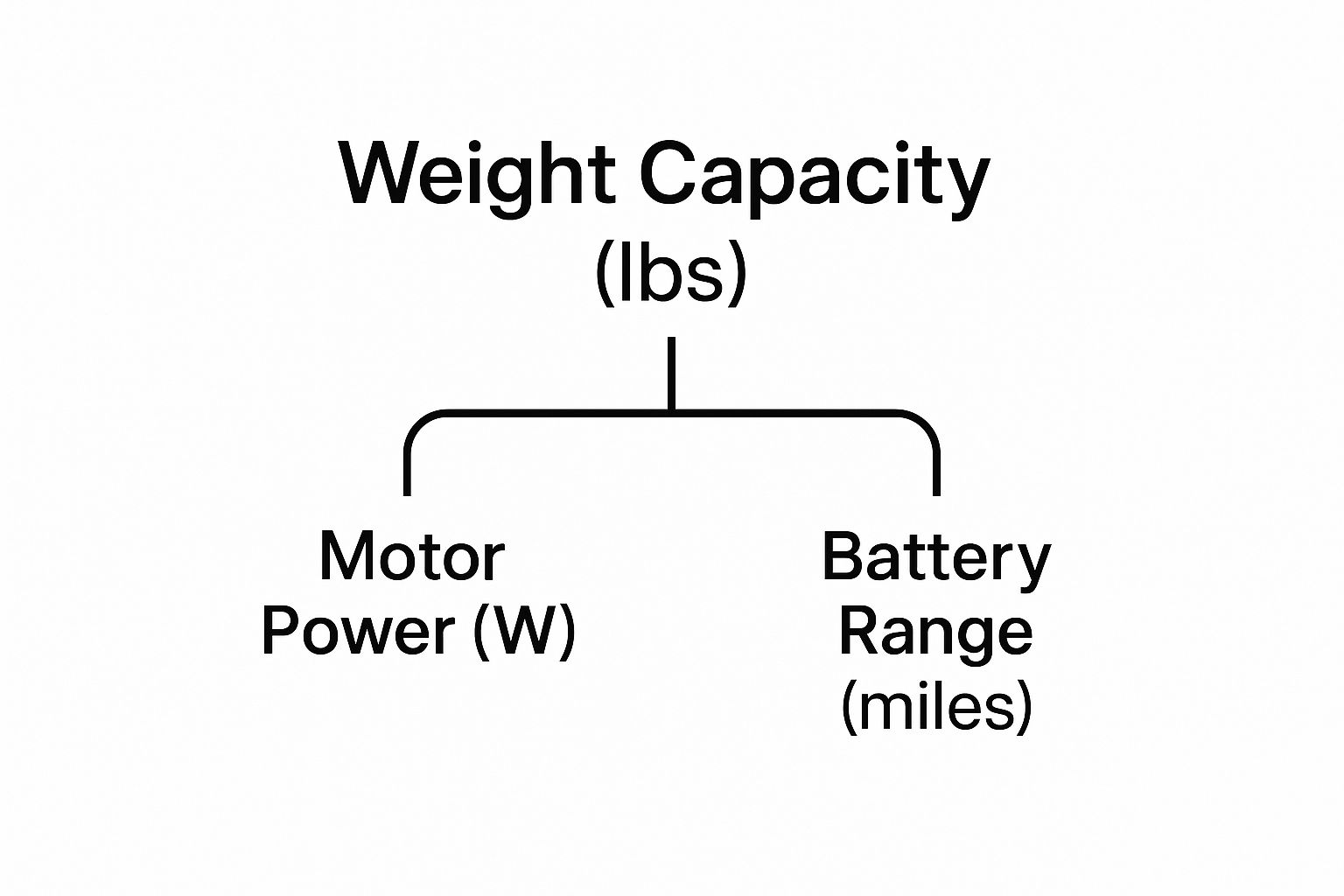
As you can see, it's a chain reaction. To handle more weight, you need more power. To feed that power, you need more juice.
It’s More Than Just a Number
Ignoring the weight limit isn't something you can just get away with. Sooner or later, the bike will let you know it's not happy. The fallout is both expensive and dangerous.
Here's a breakdown of what happens when a bike is constantly overloaded:
- Your Safety is Compromised: Brakes are designed to stop a specific amount of mass. Add more weight, and your stopping distance gets longer. In an emergency, that extra few feet could be the difference between a near miss and a nasty crash.
- Performance Takes a Nosedive: The motor has to work way harder to get you moving and climb hills. It'll feel sluggish and can even overheat, which can cause permanent damage.
- The Bike Wears Out Faster: Think about the stress on the frame welds, the wheel spokes, the suspension—everything. Overloading puts every component under constant strain, leading to premature failure.
- Kiss Your Warranty Goodbye: If a part breaks and the manufacturer figures out you've been riding over the weight limit, they're well within their rights to void the warranty. That leaves you holding the bag for a potentially huge repair bill.
Choosing an ebike built specifically for higher weight capacities isn't just a good idea—it's absolutely essential for a safe, reliable, and enjoyable ride. The best ebikes for heavy riders are engineered from the ground up with this in mind, ensuring every part is up to the task.
For a quick reference, here’s a table that breaks down the key specs you should be looking at and why they matter so much.
Quick Guide to Ebike Specs for Heavy Riders
This table gives you a fast overview of the key components to check and explains why each one is crucial for riders needing a higher weight capacity.
| Component | What to Look For | Why It Matters for Heavy Riders |
|---|---|---|
| Payload Capacity | 150 kg (330 lbs) or higher. | This is the foundation of a safe ride. A higher rating means the frame, wheels, and components are built to handle the stress. |
| Motor Power | 750W minimum, 1000W+ is ideal. | More power is needed to provide zippy acceleration and to tackle hills without straining the motor or feeling sluggish. |
| Battery Size | 600Wh minimum, look for 720Wh+ or dual-battery options. | A heavier load and a powerful motor demand more energy. A larger battery ensures you get a practical range and don't suffer from "range anxiety." |
| Brake Type | Hydraulic disc brakes with large rotors (180mm+). | These offer superior stopping power and better heat dissipation, which is critical for bringing a heavier load to a safe, controlled stop. |
| Frame Material | Reinforced 6061 or 7005 aluminum alloy or steel. | A robust, well-welded frame is the backbone of the bike. These materials provide the strength needed to prevent flexing and failure. |
| Tires | Wide, puncture-resistant tires (3" to 4"+). | Wider tires (fat tires) provide a larger contact patch for better stability, traction, and a more cushioned ride. |
Looking at these specs together gives you a complete picture of whether an ebike is truly built to last for a heavier rider. Don't just focus on one—they all work together to give you a great experience.
Understanding Motor Power and Battery Range
A beefy frame is the starting point, but it's the motor and battery that really make the bike go. For bigger riders, a powerful motor and a high-capacity battery aren't just nice-to-haves—they're non-negotiable. Without the right setup, you'll get a bike that feels sluggish, groans its way up hills, and leaves you constantly glancing at the battery gauge.
I like to think of it like this: a tiny engine is perfect for a little compact car, but you wouldn't use it to haul a heavy trailer. You'd grab a truck with an engine built for serious pulling power. It’s the exact same idea with an ebike. You need a motor that delivers raw grunt, not just a flashy top speed.
Why Torque Matters More Than Watts
When you start digging into ebike specs, you’ll see two main numbers for the motor: Watts (W) and Newton-meters (Nm) of torque. Watts are a measure of the motor's overall power output, kind of like horsepower in a car. It's a useful number, but for a heavier rider, torque is the real MVP.
Torque is the twisting force that gets you going from a dead stop and muscles you up steep inclines. It’s the get-up-and-go. A motor with high torque makes a world of difference in how responsive the bike feels, giving you that peppy acceleration and making hills feel surprisingly flat.
For the best ebike for heavy riders, here are the numbers you should be looking for:
- Motor Power: Don't even consider anything less than a 750W motor. For a truly confident ride, a 1000W motor is even better.
- Motor Torque: Shoot for 80 Nm of torque or higher. This is your guarantee that the bike has enough muscle to tackle hills and get up to speed without straining itself.
This kind of power becomes absolutely critical if you live in a hilly area. If you're expecting to climb some serious grades, it's worth taking a peek at our guide on the best electric bikes for hills to see just how much these specs matter.
A classic rookie mistake is getting fixated on watts alone. A 750W motor with 90 Nm of torque will feel way more capable and powerful under a heavy load than a 750W motor with just 50 Nm, especially when you're trying to start on an incline.
Connecting Power to Battery Range
Of course, a powerful motor is a thirsty one. It needs to pull a lot of energy from the battery to deliver that awesome torque. This brings us to the other side of the coin: the battery. Pairing a beastly motor with a wimpy battery is a surefire way to have a very short, very disappointing ride.
Battery capacity is measured in Watt-hours (Wh). Think of this as the size of your gas tank. The bigger the Wh number, the farther you can go on a single charge. Simple as that.
For a heavy rider pushing a powerful motor, a little 400Wh or 500Wh battery isn't going to cut it. The motor's demands will drain it in no time, particularly if you love using the throttle or riding in the higher pedal-assist modes. You've got to match the motor's brawn with a battery that has plenty of stamina.
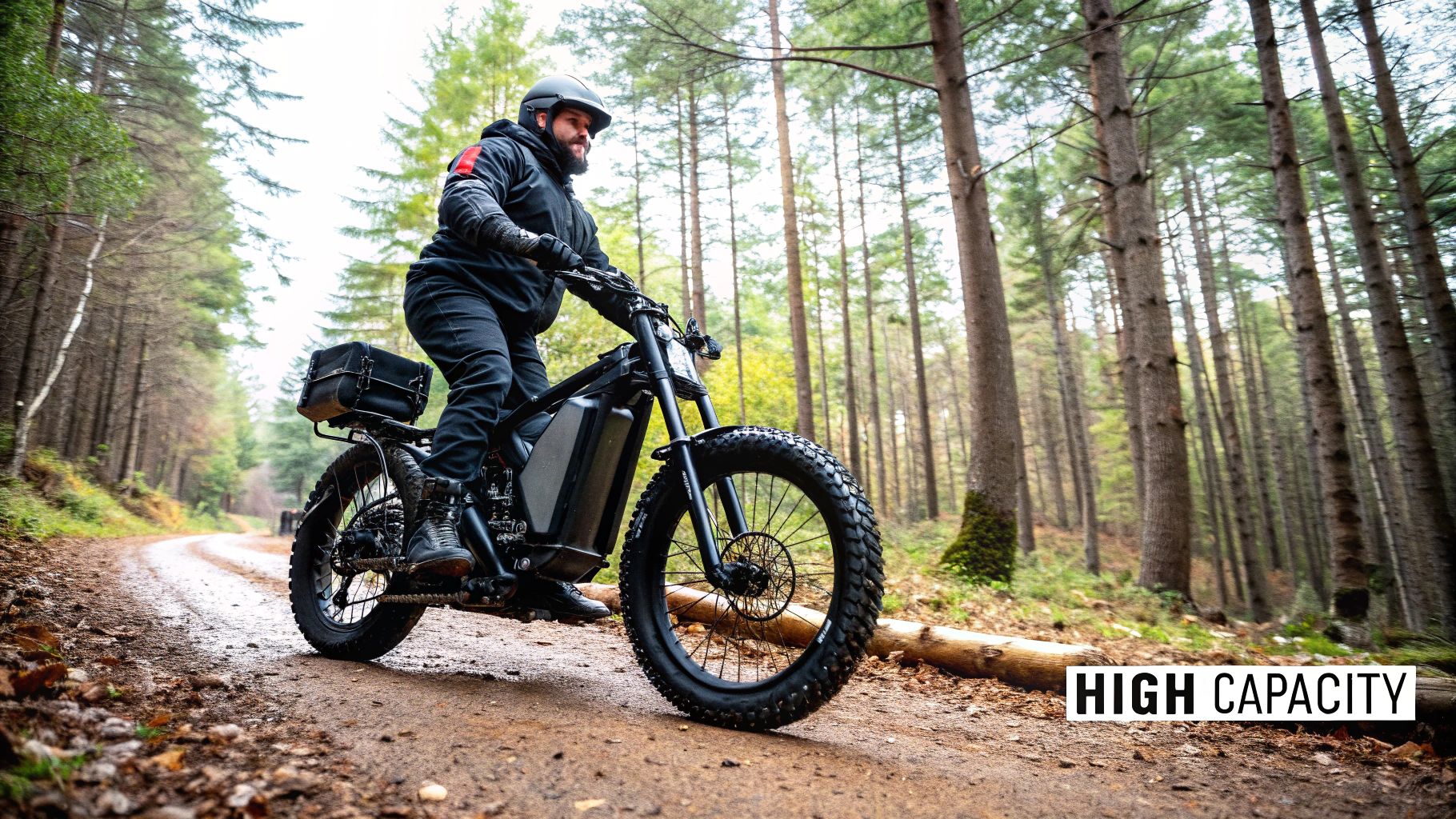
Look for a battery that's at least 600Wh to get a decent, practical range. Honestly, the best heavy-duty ebikes often come with even larger batteries, pushing 720Wh, 960Wh, or sometimes feature dual-battery setups that go beyond 1,000Wh.
This is what gives you the freedom to go on long weekend adventures or tackle your hilly commute without constantly worrying if you'll make it home. At the end of the day, it's the combo of a high-torque motor and a high-capacity battery that creates a truly powerful, fun, and stress-free ride.
Looking Beyond the Frame to Brakes and Wheels
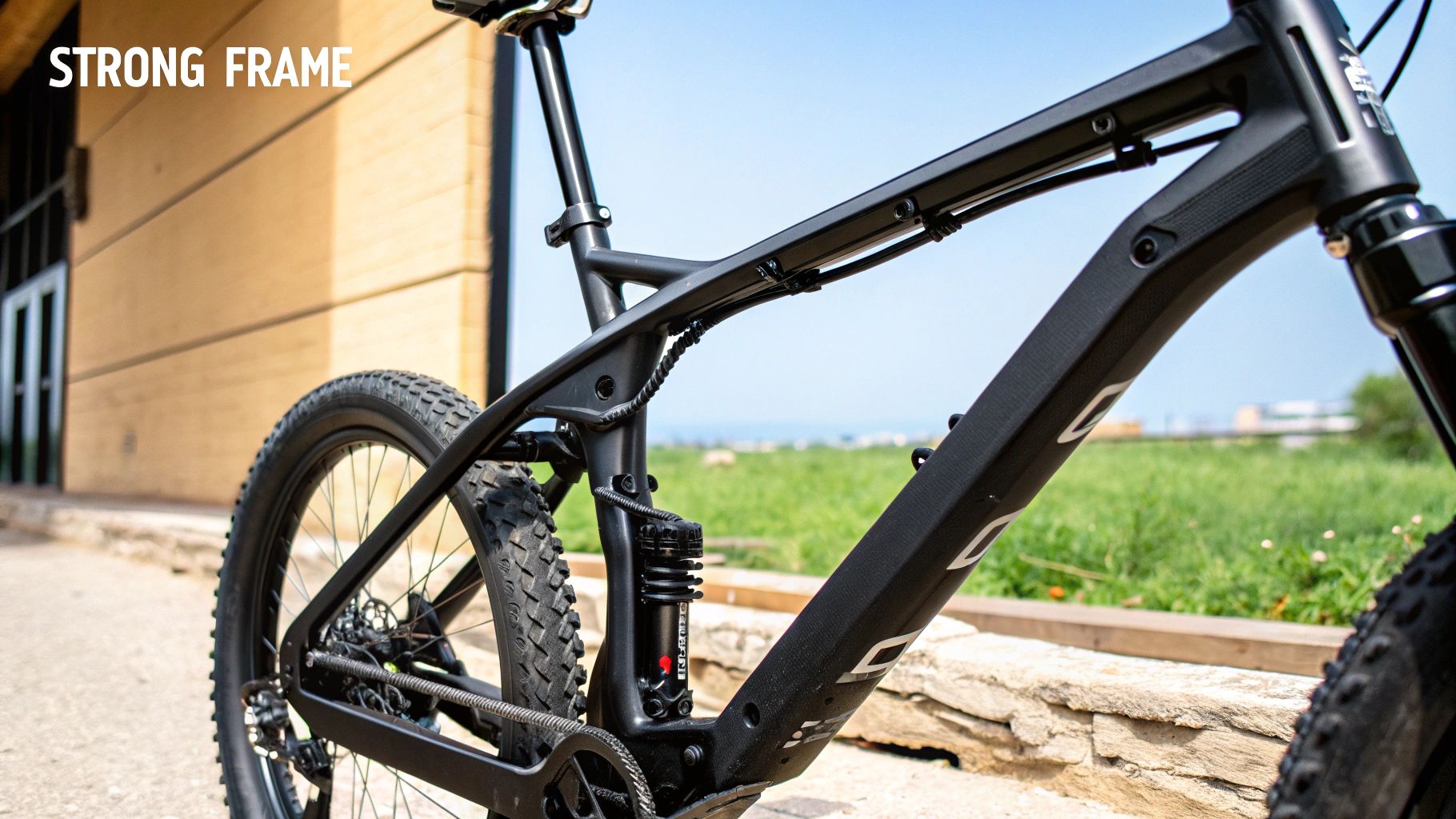
So, you've found a bike with a high payload capacity. That’s a great start, but a bike is only as strong as its weakest link. A beefy frame is one thing, but what about the parts that actually handle the stopping, starting, and rolling over bumps? The real secret to finding the best ebike for heavy riders lies in looking closely at the components that take the most abuse—the brakes, wheels, and suspension.
Manufacturers know this better than anyone. It’s a bit of an industry inside secret that a bike's official weight limit is often set to protect these critical components, not because the frame itself is on the verge of snapping.
And honestly, it’s a smart move. A tough frame won’t do you much good if your spokes start popping or your brakes can’t bring you to a safe stop on a dime.
The Critical Role of Brakes and Wheels
For a heavier rider, standard, off-the-shelf bike parts just aren't going to cut it. The extra momentum and force put every single component under greater stress, especially when you need to stop fast or hit an unexpected pothole.
Here’s why these unsung heroes are so important:
- Brakes: It’s simple physics—more weight equals more momentum. Standard mechanical brakes can feel spongy and weak under that kind of load, leading to longer, hair-raising stopping distances.
- Wheels: The wheels support your entire weight plus the bike's. Single-walled rims, common on cheaper bikes, can easily buckle or have spokes loosen under the constant pressure.
This is why some brands are transparent about their ratings. For instance, Vvolt, a respected ebike maker, has frames tested for up to 200 kg but caps the official rider weight at 136 kg on newer models. They do this specifically to protect the wheels and brakes and ensure they last. You can read more about their approach to ebike weight limits and component safety on Vvolt.com.
Must-Have Components for a Heavy-Duty Ride
When you're scanning a spec sheet, these are the parts that scream "heavy-duty." Don't settle for less.
1. Hydraulic Disc Brakes
This is non-negotiable. Hydraulic disc brakes offer way more stopping power than their mechanical cousins. They give you a much more responsive feel at the lever, bringing you to a quick, controlled halt with less effort—absolutely essential for safety. Also, keep an eye out for larger rotors (the metal disc itself), ideally 180mm or bigger, as they do a better job of managing heat and providing braking force.
2. Double-Walled Rims
Your wheels need to be tough as nails. Double-walled rims have an extra internal wall that provides a huge boost in strength and rigidity. This design is what keeps the wheel from bending or warping under load, making sure it stays true even after hitting rough patches.
3. Strong Spokes and Hubs
Look for bikes with thicker gauge spokes (like 12- or 13-gauge) and heavy-duty hubs. These components are the backbone of the wheel's strength and are crucial for handling the torque from a powerful motor and the stress from a heavier rider.
The ultimate test of a heavy-duty ebike isn't just its frame—it's whether the brakes can stop you confidently on a steep hill and the wheels can handle a surprise pothole without flinching. These components are your primary safety net.
Just as braking is vital for an ebike, it's a key consideration for other personal electric vehicles, too. For a wider view, check out our guide where we compare electric scooter models and see how their components stack up.
Investing in an ebike with robust wheels and brakes gives you the confidence to ride anywhere, knowing your bike is truly up to the task. It's the difference between a ride that feels solid and secure and one that feels shaky and uncertain.
Top Recommended Ebikes for Heavy Riders
Alright, let's talk about the bikes themselves. Finding a great e-bike in the UK or the EU can feel like looking for a needle in a haystack, especially when you need one that can handle a higher weight load. So many of the popular models are built for an "average" rider, leaving a big gap for anyone who needs something more substantial.
This is where we cut through the noise. The e-bikes I’m about to show you aren’t just models with a slightly higher number on the spec sheet. These are top-tier choices that are genuinely engineered for bigger folks, built with the powerful motors, beefy frames, and strong components we’ve been talking about. Let’s look at exactly why these bikes are the right tool for the job.
Finding Heavy-Duty Ebikes in a Niche Market
First, we need to set some realistic expectations. E-bikes designed to handle a combined rider and cargo weight over 170 kilograms (around 375 pounds) are still a pretty specialized part of the market. It's just a fact that options have historically been slim.
For a little perspective, check out the 2025 KTM e-bike catalog. Out of 194 different models, only nine are rated for a total weight over 150 kilograms. That tells you just how small this category is, but the good news is that more brands are finally starting to listen. You can get a deeper look at the market for heavy-duty ebikes over at ebike24.com.
Even with the limited selection, a few brands have really stepped up, creating fantastic machines that don't skimp on performance or safety. These bikes nail all the key features: high-torque motors, big batteries, and reinforced parts like hydraulic brakes and tough wheels. Let's dive into some of the best ones out there.
Riese & Müller Multitinker Vario: The Cargo Powerhouse
The Riese & Müller Multitinker Vario is a premium cargo e-bike that happens to be one of the best options for heavier riders in Europe. It boasts an impressive total permissible weight of 200 kg (440 lbs). This isn't just a bike with a strong frame; it's a complete transport system built for heavy loads, whether that's a larger rider, cargo, or both.
So, what makes it a top contender?
- Motor Torque: It features the Bosch Performance Line CX motor, delivering a powerful 85 Nm of torque. This ensures effortless starts and commanding performance on hills, even when carrying significant weight.
- Built-in Durability: The entire bike is over-engineered for strength. From the 20-inch wheels designed for stability under load to the powerful Magura hydraulic disc brakes, every component is chosen to handle stress.
- Practicality and Comfort: It includes integrated front suspension and a suspension seatpost for a smooth ride. Plus, its cargo capabilities mean it’s incredibly versatile for daily errands or family outings.
For riders in the UK and EU who want a bike that combines a high weight capacity with everyday usability and premium German engineering, the Multitinker is a standout choice.
Cube Kathmandu Hybrid 750: The Long-Range Adventurer
Another fantastic option is the Cube Kathmandu Hybrid 750. Cube is a well-respected German brand, and the Kathmandu line is built for long-distance touring, which means durability is a core feature. It has a maximum system weight of 160 kg (352 lbs), making it a solid choice for bigger riders who want to explore.
The real value of a heavy-duty e-bike is the confidence it inspires. When you know your bike is built to handle your weight, you can stop worrying and just focus on the joy of the ride.
Let's break down what makes the Cube Kathmandu stand out:
- Motor and Battery: It’s also equipped with the powerful Bosch Performance CX motor (85 Nm) and a massive 750Wh battery. This combination provides both the muscle for climbs and the stamina for all-day adventures without range anxiety.
- Comfort and Ergonomics: With an air suspension fork and a comfortable, upright riding position, the Kathmandu is designed to keep you comfortable on long journeys, reducing strain on your back and shoulders.
- Integrated Design: It comes fully equipped with a robust integrated rear rack, mudguards, and lights. It’s a complete package designed to be ridden straight from the shop on any adventure.
These two e-bikes are great examples of what’s available in the growing—but still niche—market for bigger riders in the UK and Europe. By focusing on models like the Riese & Müller Multitinker and the Cube Kathmandu, you can find a machine that doesn't just meet your weight requirements but delivers a powerful, secure, and incredibly fun ride.
It’s All About a Comfortable Ride
Power and a high weight limit are great, but what's the point if riding your e-bike feels like a medieval torture device? For bigger and taller folks, finding a bike that actually fits your body is the real secret to unlocking miles of fun. It’s the difference between eagerly planning your next ride and making excuses to leave the bike in the garage.
An ill-fitting bike isn't just about a sore rear end—it can put serious strain on your back, wrists, and shoulders. The best ebike for heavy riders doesn’t just hold your weight; it promotes good posture and gets rid of those painful pressure points. This is all about ergonomics, making sure the bike works with you, not against you.
Frame Geometry and Making It Your Own
A comfortable ride starts with the frame. For a lot of us, just getting on and off a bike can be a bit of a production. This is where a step-through frame can be a total game-changer. By getting rid of that high top bar, you can just step right through, making mounting and dismounting a breeze.
Beyond the frame style, adjustability is your best friend. You want a bike you can tinker with to get the fit just right for your body.
- Adjustable Handlebars: Being able to change the height and angle of the handlebars is huge. Swept-back or cruiser-style bars are fantastic because they let you sit upright in a more relaxed position, taking all that pressure off your lower back and wrists.
- Adjustable Seat Post: Getting your saddle height right is crucial for comfortable, powerful pedaling and keeping your knees happy. A good range of adjustment here is non-negotiable.
Honestly, for most riding, an upright posture is the way to go. It spreads your weight out more evenly and saves you from the neck and shoulder strain that comes from leaning forward all the time.
The Saddle and Suspension: Your Comfort Dream Team
If the frame is the foundation, the saddle is the throne you'll be sitting on for hours. Let’s face it, the stock saddles that come with most bikes are often narrow, hard, and unforgiving. For heavier riders, a wider, well-cushioned saddle isn't a luxury—it's a necessity.
A wider saddle gives your sit bones more surface area to rest on, which makes a world of difference. Many riders also swear by saddles with built-in springs or little rubber bumpers that add another layer of shock absorption. It’s a simple upgrade that pays off big time.
A huge mistake people make is overlooking suspension. For a heavy rider, suspension isn't a fancy add-on; it's a core feature for a smooth, pain-free experience. It soaks up all those jarring bumps from potholes that would otherwise shoot right up your spine.
This is why having suspension on both ends of the bike is so valuable. Here’s how they work together to keep you comfortable:
- Front Suspension Fork: This is on the front wheel, and its job is to eat up bumps before they reach your hands, wrists, and shoulders. It also gives you better control when the road gets a little rough.
- Suspension Seat Post: Think of this as a shock absorber built right into the post holding your seat. It works on its own to smooth out the bumps that hit the back of the bike, directly protecting your lower back.
When you have both, it can feel like you're floating over choppy pavement. It completely changes the ride, letting you go further and stay comfortable. Focusing on these ergonomic details from the start will make sure your e-bike is a trusty partner for adventure, not a source of aches and pains.
Answering Your Top Ebike Questions
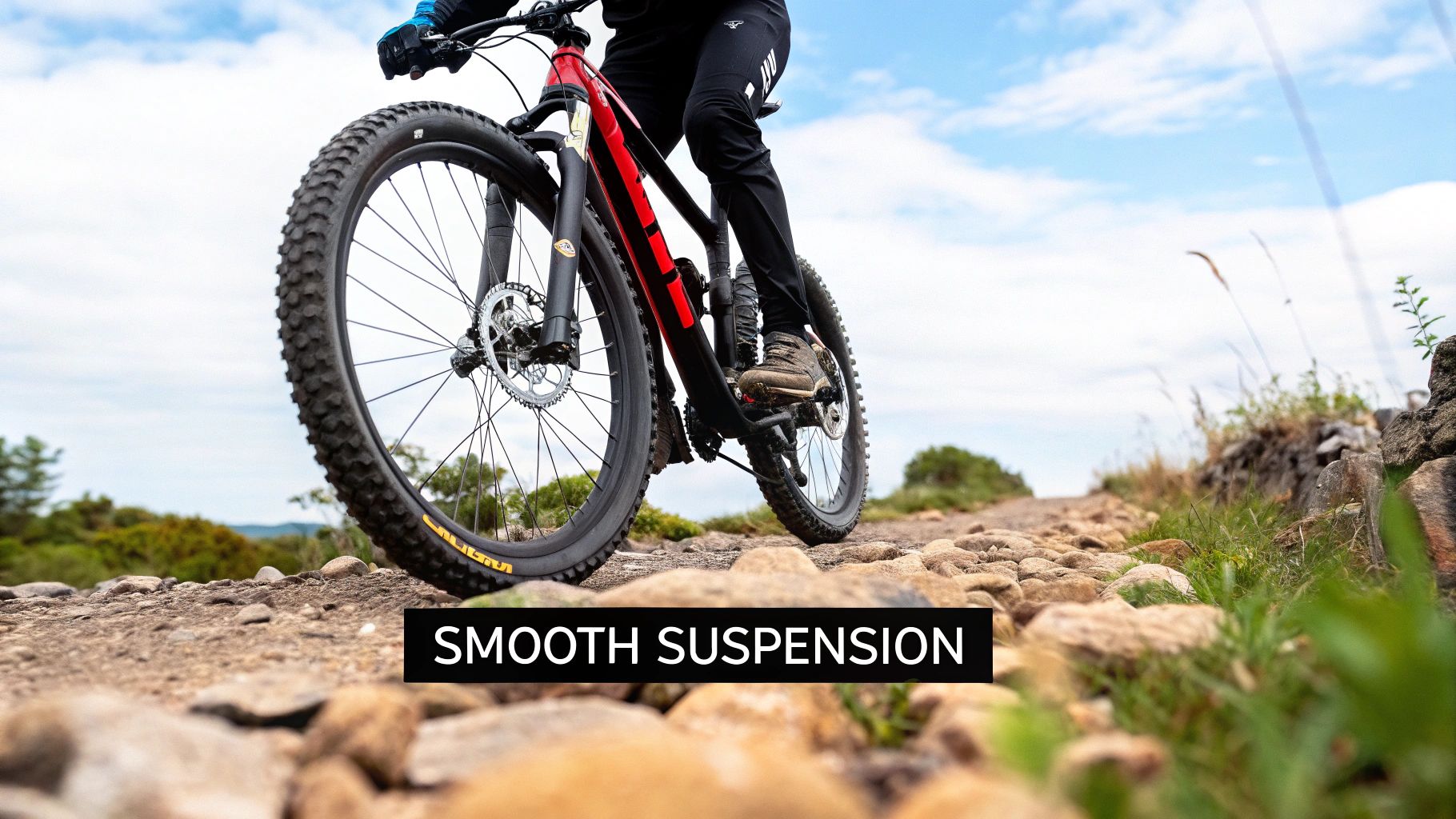
Alright, even after digging through all the specs, you've probably still got a few questions bouncing around. That’s completely normal. Dropping some serious cash on an ebike is a big deal, and you want to be sure you’re making the right call.
To help you out, we’ve tackled the most common questions we get from heavier riders. Think of this as the final check-in before you commit, so you can buy with total confidence.
Can I Upgrade a Standard Ebike for a Higher Weight Capacity?
I hear this one all the time, and the answer is a hard no. You can absolutely swap out parts like the seat or even the wheels for something better, but you can’t change the one thing that matters most: the frame’s official weight limit. That number is baked in by the manufacturer based on serious engineering and safety tests.
Trying to beef up a standard bike to carry more weight is just asking for trouble. Not only is it unsafe, but you'll also kiss your warranty goodbye in the process. It's always smarter—and safer—to get an ebike designed from the ground up to handle your weight.
Do Fat Tyre Ebikes Automatically Support More Weight?
It's an easy assumption to make. Fat tyres look tough, give you a super stable ride, and yeah, a lot of heavy-duty ebikes have them. But here’s the catch: fat tyres alone don't guarantee a high weight capacity.
The real strength comes from the frame, the wheel rims, and other key components. You can't just eyeball a bike and judge its strength by the tyre size.
Always, always, always check the manufacturer's specified payload capacity. That's the only number that really counts for your safety, no matter how burly the bike looks.
This is a good rule of thumb for any personal electric vehicle. In fact, our electric scooter buying guide gets into similar details about checking specs over looks.
What Is the Most Important Spec After the Weight Limit?
Okay, so you’ve found a few bikes with the right payload capacity. What’s next? Your focus should immediately shift to two things: motor torque and the brakes. These are the two specs that will make or break your daily ride.
Here's why they're so important:
- Motor Torque (Nm): Think of torque as the bike's muscle. A high torque number—aim for 80 Nm or more—gives you that satisfying kick of acceleration from a dead stop and lets you power up hills without the motor whining in protest.
- Braking System: When it comes to stopping, hydraulic disc brakes are non-negotiable. A heavier rider means more momentum, and you need brakes that are powerful and reliable enough to bring you to a smooth, controlled stop every single time.
Nail these two specs, and you'll have an ebike with the grunt to get going and the bite to stop safely.
How Much Will My Weight Affect the Battery Range?
Your weight is one of the biggest variables when it comes to battery range. It's simple physics: the more weight the motor has to move, the more juice it pulls from the battery.
As a rule of thumb, it's wise to expect your real-world range to be on the low end of what the manufacturer claims. You might see 20-30% less than the advertised number, especially if you’re hitting hills or love using the throttle.
The solution? Go for a bigger battery. A capacity of 600Wh is a decent starting point, but if you can find something with 750Wh or more, you'll buy yourself a lot more freedom and peace of mind on longer rides.
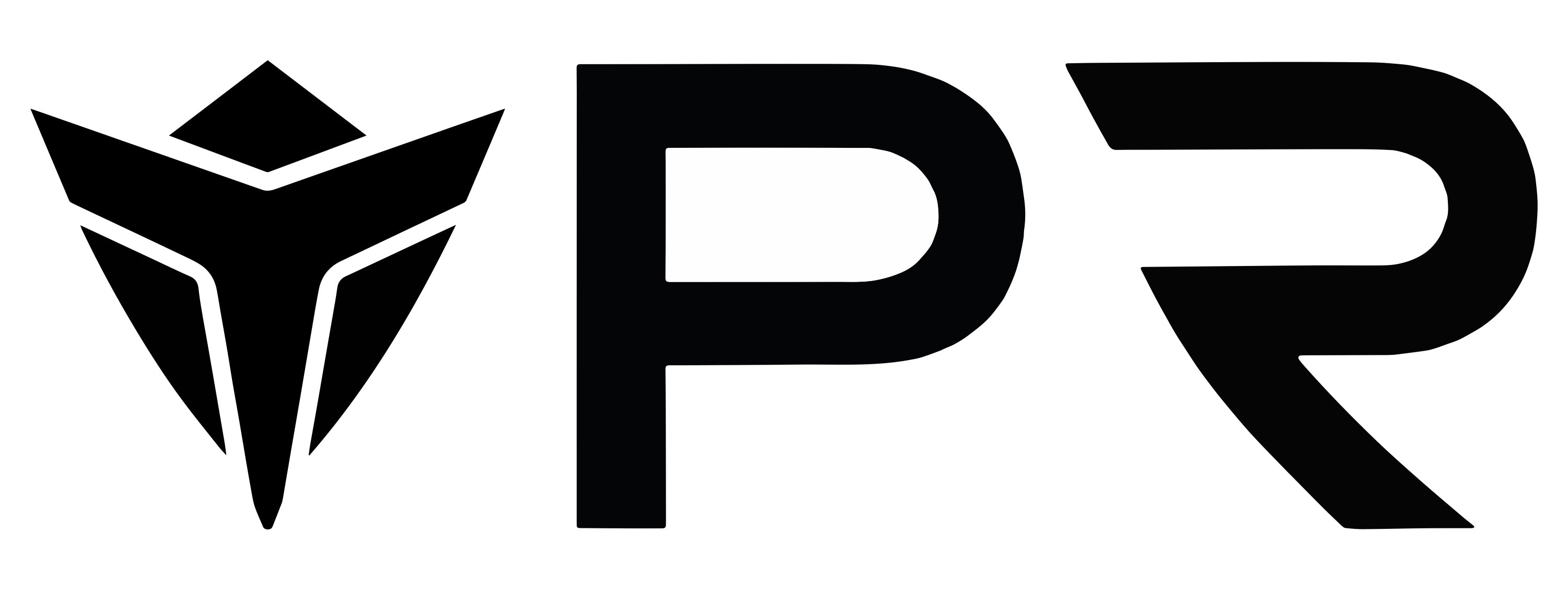
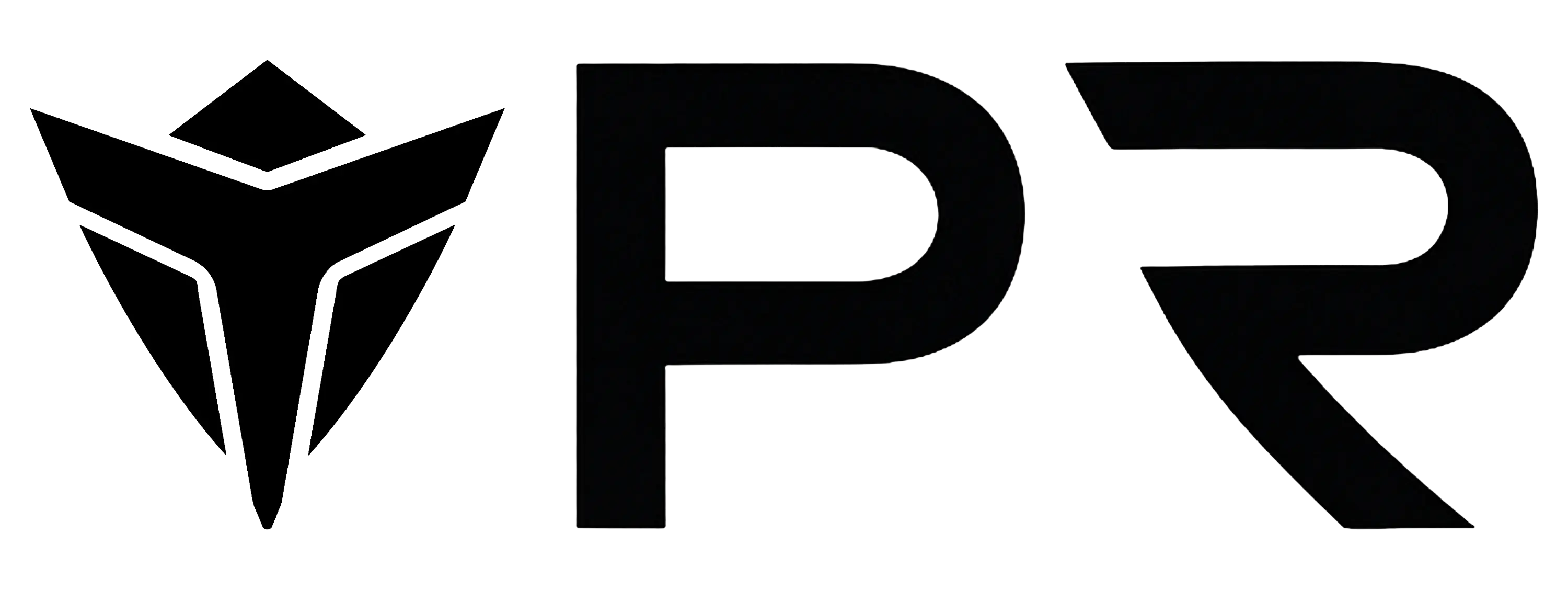


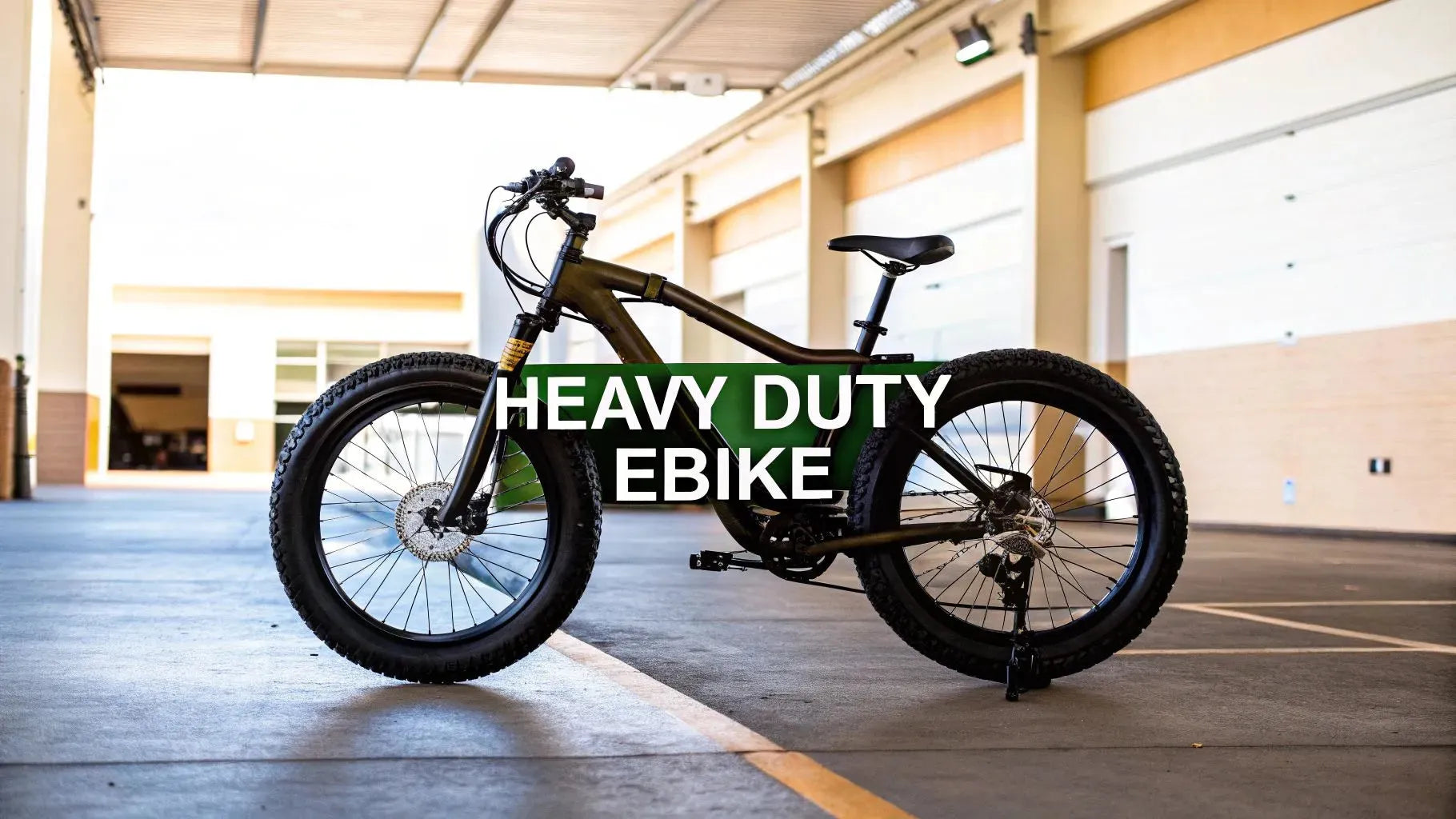
Share:
Top Picks: Best Electric Bikes for Hills in 2024
Top 10 Best Electric Bike Under 2000 Pounds in 2024